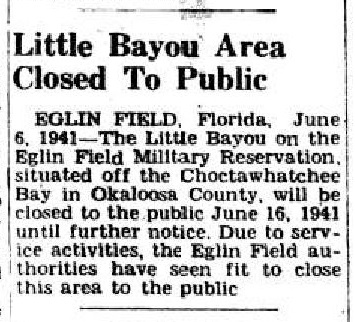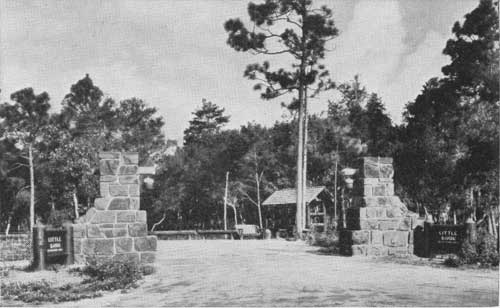Choctawhatchee National Forest
(A section of the NICEVILLE, FLORIDA - Online History Center)
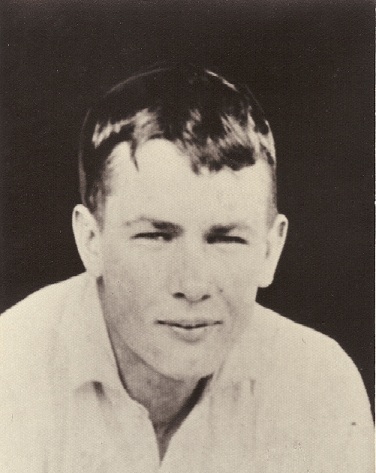 "So now I have passed my seventieth
birthday, my consulting work leaves me increasing leisure to spend the winter
here in New Orleans and the summer at our cottage, Amity, on Garniers Bayou,
just one hundred yards south of my first love, the old Choctawhatchee National
Forest in Florida, where I like to educate my grandchildren in the arts of
boating and fishing and to regale them with tales of high adventure that only an
old forester can tell."~ Captain Inman Fowler "Cap"
Eldredge, 1954 (Note:
Photo on right of young I.F. Eldredge.)
"So now I have passed my seventieth
birthday, my consulting work leaves me increasing leisure to spend the winter
here in New Orleans and the summer at our cottage, Amity, on Garniers Bayou,
just one hundred yards south of my first love, the old Choctawhatchee National
Forest in Florida, where I like to educate my grandchildren in the arts of
boating and fishing and to regale them with tales of high adventure that only an
old forester can tell."~ Captain Inman Fowler "Cap"
Eldredge, 1954 (Note:
Photo on right of young I.F. Eldredge.)
CHOCTAWHATCHEE NATIONAL FOREST ESTABLISHED (The Pensacola Journal 12/05/1909)
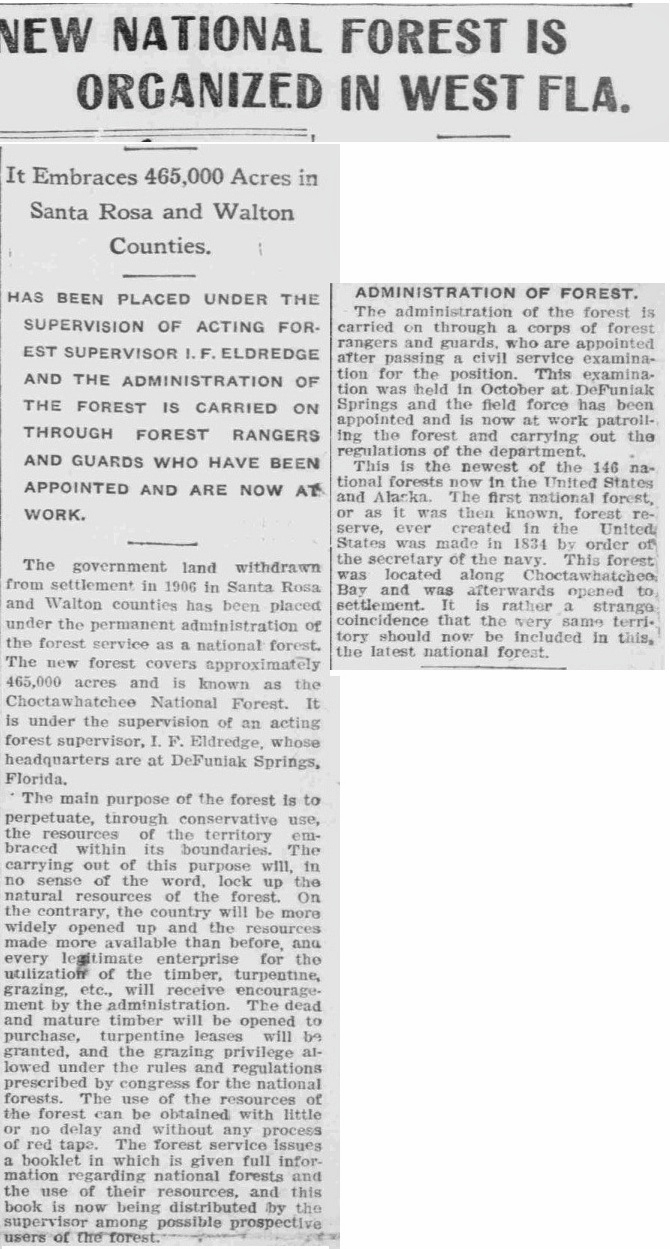
Boggy News: "Supervisor Eldredge, of the U. S. Forest Reserve, was transacting here and at Rocky, Saturday."
"The government boat which will be used in the Forest Service is in Pensacola and A. G. Browne has gone to bring it in the first of the week." (The Breeze 7/14/1910)
1917 Florida National Forest Western Division Map: (Note: I F. Eldredge is the Forest Supervisor, Pensacola, Fla. The legend shows the Ranger Station at Camp Pinchot (on Garniers Bayou) as the summer headquarters. Below is the section of the map showing the Niceville area.

FLORIDA NATIONAL FORESTS, USDA FOREST SERVICE PUBLICATION, 1939
Lands in National Forests: "Since Florida was the only Southern State east of the Mississippi River that had any large tracts of public domain when the national-forest system was established, it was the first State in the Southeast to have a national forest.
From the public domain lands, President Theodore Roosevelt in November 1908 proclaimed the western division, the Choctawhatchee National Forest, and the eastern division, the Ocala National Forest. During the administration of President Taft in 1911, these areas were combined under the designation of the Florida National Forest. Even though these areas belonged to the public domain, they had not been immune to the lumbermen's ax or to the carelessly tossed match. Wasteful cutting and unrestrained burning had exacted their toll; and when the areas were placed under the administration of the United States Forest Service, they contained large tracts of privately owned cut-over lands, just called "idle acres".
When a national forest is acquired, detailed surveys are made to determine the amount of lumber and other timber products that are on it, the quality of the timber, and the rate of growth. This information is compiled and used to formulate a definite plan for the management of the forest, and for development of each particular area for the purpose it can best serve. A protection and improvement system is planned and inaugurated. Roads, firebreaks, and telephone lines are constructed, and lookout towers and guard stations are built where they will be most valuable. The actual work of putting the management plan into effect is then started. This may consist of planting cut-over areas, thinning and improving timber stands, conducting timber sales, developing recreation areas, and improving wildlife conditions.
Benefits to Local Communities: When forest products on the national forests are ready for sale, they are appraised, advertised, and sold to the highest bidder. Money received for these forest products is paid to the Treasurer of the United States. Out of every dollar received, 25 cents is returned to the counties in which the forest lies in lieu of taxes, to be used for schools and roads. In addition, the Forest Service is obligated to spend an additional 10 percent of these receipts for the improvement of roads in the forest. Total net receipts from the four Florida national forests for the fiscal year 1937 were $99,104.17. This return to the counties was approximately 10 1/2 cents per acre, an amount which exceeds the tax rate for the land in these counties. The net income for the Osceola National Forest during this period was $64,900, of which the forest counties received $16,225. The returns from the Osceola were larger than on any of the other three Florida forests because it contains the largest amount of merchantable timber and has more accessible markets.
Florida national forests are assuming their proper place in the communities in which they are located. They not only are affording direct revenue to the counties, but are furnishing work to local communities.
Working Pines For Naval Stores: For decades yellow pine, cypress, and hardwood timber, and naval stores from Florida's forests have poured a golden stream into the channels of the world's commerce. In north Florida every county and nearly every town and hamlet has its turpentine orchards and stills. This area lies within that region of the Southeast which contains three-fourths of the naval stores industry in the United States and produced approximately 85 percent of all the gum naval stores used in this country, and over half of the world's supply.
The first naval stores sale on a national forest was made on the Choctawhatchee National Forest in 1910. Since then better practices and more efficient management of lands for naval stores production have been developed on the national forests and elsewhere, especially on the Osceola National Forest." (Source: Florida National Forests United States Department of Agriculture, Forest Service, F. A. Silcox, Chief, Southern Region: Joseph C. Kircher, Regional Forester, Atlanta, Georgia, United States Government Printing Office, Washington: 1939)
Choctawhatchee National Forest (A Division of the Florida National Forests): "FROM the Indians, who occupied this region before the white man appeared, comes the sonorous name of the forest - Choctawhatchee (Choc-taw-hat-chee). It is a Creek Indian word which means "River of the Chatot," a small tribe sometimes confused with the Choctaws.
The Choctawhatchee National Forest, with a gross area of 368,048 acres, lies in the extreme western part of Florida between DeFuniak Springs and Pensacola, and includes portions of Walton, Okaloosa, and Santa Rosa Counties. The southern boundary extends to Choctawhatchee Bay and is within a few miles of the Gulf coast. The Yellow River is the northern boundary of the forest. The "Old Spanish Trail," U S 90 from Jacksonville to New Orleans, and the Louisville & Nashville Railroad run east and west a few miles north of the forest. The Gulf Coastal Highway 319 - 98 passes between the forest and the Gulf. Florida Highways 54, 218, and 10 cross the forest. The district ranger's headquarters are at Niceville.
The forest is predominantly ridge type, with longleaf pine as the dominant tree, and turkey oak as an understory. The soil supporting this type is an extremely porous, sterile sand so that the growth rate of the timber is very slow. It will, however, produce high-grade saw timber on a long rotation. That portion of the longleaf pine type on the better sites will be managed for naval stores, and the first cups will be hung when the trees are 10 inches in diameter. Thinning for pulpwood will furnish intermediate crops and the final crops will be saw timber and pulpwood. An area of sand-pine type occurs in the southeastern part of the forest. Hardwoods, cypress, and cedar grow in the stream bottoms and swamps. Many of the swamps are dense, impenetrable titi thickets. Mountain laurel, an Appalachian Mountain shrub, on Rocky Creek is of botanical interest.
Experimental work is being conducted on the reestablishment of longleaf pine on the oak ridges. With the aid of C. C. C. crews, much timber-stand-improvement work has been done. Turkey oaks, which are of little or no commercial value, are removed where longleaf saplings are overtopped or subjected to mechanical injury. The first improved naval stores practices known to the industry, many of which are in use today, were developed on the Choctawhatchee National Forest, under Forest Service supervision.
Since its establishment, this national forest has supported naval stores operations varying from 200,000 to 500,000 cups annually, depending on the economic condition of the industry. After naval stores values are exhausted, the trees are sold for saw timber. This forest has been under intensive management for nearly 30 years, and has an annual sustained yield of more than 4,000,000 feet of saw timber.
The first timber preserve established by the United States Government and the first commercial forestry project in the United States were located on Santa Rosa Island. Sea power in 1828 meant wooden ships, and President John Quincy Adams foresaw that the maintenance of a strong United States Navy depended upon a permanent supply of proper timber. Live oak was the wood par excellence for the framework of ships, so a reconnaissance was made of the live oak supply along the coasts of Georgia, Florida, Louisiana and the Carolinas. The depleted conditions reported prompted President Adams to initiate a project for the growing of this species. He withdrew from the public domain 30,000 acres of land on Santa Rosa Island across the bay from the new Pensacola Naval Station, and in December 1828, live oak acorns were planted on the area. The following year about 76,000 young trees were growing in a flourishing condition. Some of the timber from this plantation, which was cut during the Civil War and stored under water for preservation in Commodore's Pond at the Navy Yard, was removed and used in the reconstruction of the Constitution, better known as Old Ironsides, one of the most famous of the United States Navy's early fighting ships.
The Choctawhatchee area is rich in Indian, Spanish, pirate, and Andrew Jackson history. Old Indian mounds are numerous, and almost every stream or cove is featured in some historic Indian or Spanish legend. On the shores of Choctawhatchee Bay, Indian Chief Sam Storrie greeted the first white settlers to the State. The Old Military Road, or Jackson Trail, crosses the eastern portion of the forest. This road was built by Gen. Andrew Jackson's army which marched through west Florida in 1818 subduing the Spaniards and hostile Indians who had been armed by the English and were harassing Alabama and Georgia. Over this same road in 1837 was established the first United States mail route through west Florida from Tallahassee to Pensacola.
While Spain, France, and Great Britain strove for control of the territory of which the Choctawhatchee Forest is a part, the swashbuckling pirates preyed on the commerce of the Gulf of Mexico. These live-oak and pine-bordered bayous were their haven from British and Spanish men-of-war. Here they beached their ships and scraped and caulked the hulls. Tradition tells of buried treasure and the sunken galleons of these freebooters of the sea. Old "pieces of eight" and Spanish doubloons found on Santa Rosa Island have brought parties of diligent searchers to this region in the quest for buried treasure.
|
|
VIRGIN LONGLEAF PINE. THE CHOCTAWHATCHEE NATIONAL FOREST CONTAINS ONE OF THE FEW REMNANTS OF THE ORIGINAL STANDS OF VIRGIN LONGLEAF FINE IN THE UNITED STATES F—266764 |
RECREATION
The scenic attractions of Choctawhatchee Bay and its indentations and contiguous territory have won high praise, and the irregular water line, as well as the heavily wooded shores, are well known for their beauty and recreation possibilities. Just west of Valparaiso and Fort Walton on the wooded shore of one of these indentations along Florida Highway 10 is the Little Bayou recreation area developed by the Forest Service. Because of its high banks and sheltered waters, Little Bayou for many years has been used as a haven by boats of all kinds during tropical storms. Boating, bathing, picnicking, and salt-water fishing are possible at Little Bayou all the year round. Fishing and swimming may be enjoyed from the white sand beach, boats, or the diving platform which has been constructed from the beach into the waters of the bayou. A bathhouse has been provided with dressing room, toilet, and showers. Swings, see-saws, and sand boxes have been made available for children. There are tables, open fireplaces for cooking, shelters, benches, campfire circles, rustic shelters, incinerators, and other sanitary facilities.
A golf course and several beach and summer resort hotel developments are located on the shores of Choctawhatchee Bay. Forest Service facilities and the beautiful scenic views of the forest are added attractions.
|
|
ENTRANCE TO LITTLE BAYOU RECREATION AREA F—352830 |
HUNTING AND FISHING
The Choctawhatchee Forest supports a large herd of deer, some wild turkeys, and numerous small game, such as red foxes, squirrels, and quail. In cooperation with the State Commission of Game and Fresh Water Fish, a game preserve was established on the southwest side of the forest in 1925, and when present plans are carried out, hunting and fishing on this forest will be one of the major forms of recreation. To meet the present demand, plans are now formulated for the construction of improved hunting and fishing camps, the first of which will probably be constructed along Lightwood Knot Creek.
Fresh-water fishing is furnished by numerous streams, the most important being Yellow River on the north and west boundaries, and East Bay River, Juniper Creek (today's Turkey Creek at the head of Boggy Bayou), and Rocky Creek (flows into Rocky Bayou) in the southern portion of the forest. Fishing for salt-water trout, Spanish mackerel, mullet, red fish, flounder, and many other varieties of food and game fish in the bayous and inlets of Choctawhatchee Bay is very popular. Niceville is the base of commercial fishing operations in the Gulf which furnish fish to the inland cities of the North." (Source: Florida National Forests United States Department of Agriculture, Forest Service, F. A. Silcox, Chief, Southern Region: Joseph C. Kircher, Regional Forester, Atlanta, Georgia, United States Government Printing Office, Washington: 1939)
Back cover below of the 1939 Florida National Forests United States Department of Agriculture, Forest Service Publication:

FOREST RANGERS AND CCC CAMP 1402 USFS OFFICERS
USFS personnel by 1910 and 1920 census records: In the 1910 census, the U. S. Forest Ranger was Elijah R. McKee. The U. S. Forest Guard was Alexander Browne. In the 1920 census, Garner B. Anchors was the Forest Ranger. (Note: In 1938 the Florida National Forests Supervisor's Headquarters were at Tallahassee while the Choctawhatchee Forest Service Office was at Niceville.)

Photo Below of Forest Ranger G.B. Anchors and His Wife Pearl Burlison Anchors:
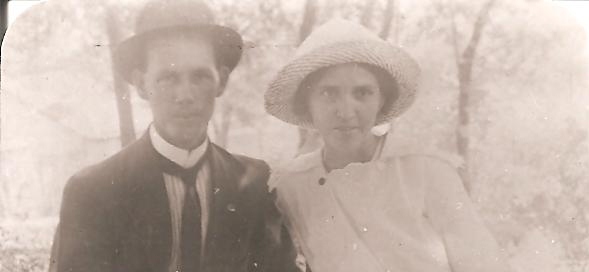
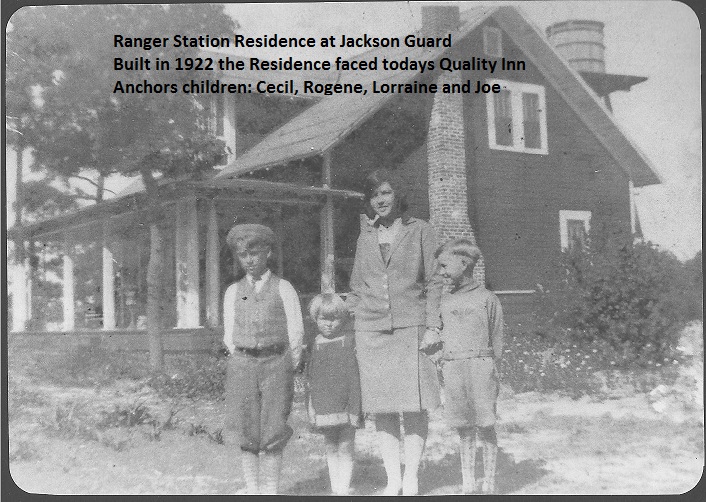

The Boggy Bayou Breeze VOL. 1 Company 1402 Niceville, Florida Tuesday, February 12th 1935: (Note: The following information was transcribed from this CCC newsletter showing USFS personel serving as officers in CCC Camp 1402 Niceville, Florida.)
Company Rated List:
Leaders:
Adams, J. Q. -
USFS
Beck, C. T. -
Cook
Ellison, Mr. R. -
Grader
Hayslip S. W. -
Mess Steward
Holms, J. C. - USFS
Holms, J. R. - USFS
Lee, F. P. - Supply
Sergeant
Holmes H. W. - USFS
Newton, W. B. - Cook
Wait, D. K. - 1st
Sgt.
Assistant Leaders:
Aldrich, R. H. - USFS
Bush, C. J. - USFS
Chamberlin, D.
- Company Clerk
Hawkins, H. I. - USFS
Hester, R. J. - Cook
O’Orange F. J. - Cook
McCullough, I. S.
- USFS
McDuffie, S. Jr.
- ACEA
McMichon, V. A.
- USFS
Nathey, W. J. - USFS
Pitts, C. J. - USFS
Purvis, W. D. - USFS
Save, J. L. Jr.
- Forest Clerk
Webb, J. T. - Cook
Willingham, Joel
- USFS
Elliott, S. - USFS
(Source: copy of this newsletter courtesy of the University of Florida George A. Smathers Libraries Department of Special and Area Studies Collections)
FOREST WORK OF CIVILIAN CONSERVATION CORPS CAMP 1402, NICEVILLE
Accomplishments: The accomplishments of the boys "in the woods" is so stupendous that cold figures do not adequately express what has actually been done in the Choctawhatchee National Forest, largest National Forest in the south. Millions of seedlings raised and planted; hundreds of miles of roads and trails constructed and maintained; bridges, both wooden and concrete, built across dozens of crystal clear streams; section after section improved in timber stand by release of pines from worthless growth; millions of feet of lumber marketed and thousands of barrels of turpentine and resin manufactures; fires held down to an incredible minimum acreage of loss; miles of telephone line constructed; buildings and towers erected and countless other things, some small, some large, but all important." (Source: Official Annual of District "G" Fourth Corps Area, 1936. Civilian Conservation Corps. Presswork and Typography by Ruralist Press, Inc., Atlanta, Georgia. Engravings by Shreveport Engraving company, Shreveport, Louisiana. Published by Direct Advertising Company, Baton Rouge, Louisiana. 1936. (District HQ, Fort Barrancas, Pensacola, FL)
History of Company 1402 (from 1934) Fla. F-3 Niceville, Florida:
The company's average time for getting out of camp on fire duty is less than
three and one-half minutes.
For a work record,
how is this:
Maintained four
lookout towers which include landscaping, painting, construction, etc; 37,164
acres forest timberstand improvement as of May 25; average number of bridges
per week, three or four crews; telephone lines constructed, 32 miles; telephone
lines maintained, 57 miles; fire lanes constructed, 177 miles; fire lanes
maintained, 275 miles; truck trails constructed, 80 miles; truck trails
maintained, 198 miles; 2 buildings and 2 towers constructed; 56 acres
landscaping; 80 acre landing field surveyed, stumped and cleared.
Source:
Memories of District G, Civilian Conservation Corps, 1934. Civilian
Conservation Corps. Typography and Presswork by Parke-Harper Company, Little
Rock. Engravings by Peerless Engraving Company, Little Rock. 1934. (District HQ,
Fort Barrancas, Pensacola, FL)
Trees Transplanted:
Rupert Brown
reports that the first trees to be transplanted in the Choctawhatchee Area,
since the CCC, were set today.
(Source: The Boggy Bayou Breeze VOL. 1 Company 1402 Niceville, Florida, Tuesday, February 12th 1935.
This newsletter courtesy of the University of Florida George A. Smathers
Libraries Department of Special and Area Studies Collections)
Monday was a busy day for Co. 1402. The boys were called from their much needed slumber to go to a fire at 4 o'clock in the morning. Under directions of Forest Ranger Snyder, Asst. Ranger W. L. Davis and Fire Guard Tom Brown of the Forest Service and Leader J. Q. Adams assisted by Asst. Leader C. J. Bush. The fire was quickly put out. The boys returned to camp for breakfast at the usual time. But that is not all. Another detail of men were called from their beds at 3:45 to go to a fire on Weaver Creek Tower, about 40 miles from camp. All the field crew from Metts Side camp were called out to fight this fire. The boys from Metts returned to Metts last night but the boys from here had to stay in the woods all night. They arrived in camp about 6:30 and were they wet, and HOW! Chow was served to them and they fell in their bunks and some didn’t make the noon chow line.
The Weaver Creek fire was the largest of the season, on the West side of the Metts District. This fire was brought under control under the direction of Bill Stevens who was assisted by Foreman McCray, Asst. Leader Clyde Pitts, Asst. Leader C. J. Bush from Camp and Walker Spence and Fire Guard Tom Brown from the Ranger Station.
Fills continue to go on record time. And they will as long as McMichen and Bush are the bosses. Just ask the boys who shovel the sand and drive the trucks. (Source: The Boggy Bayou Breeze VOL. 1 No. 5 Company 1402 Niceville, Florida, Tuesday, March 12th 1935. This newsletter courtesy of the University of Florida George A. Smathers Libraries Department of Special and Area Studies Collections)
Photo below is the aerial view of the Choctawhatchee National Forest Headquarters at Niceville (today known as Jackson Guard) with fire tower, buildings and CCC Camp 1402 barracks: (Note: The temporary CCC tents formerly on the school property have been replaced with permanent barracks across from what is now SR 85 from Niceville to Crestview. On October 1, 1939 Forest Camp 1402 moved to Otter Creek, FL. On October 1, 1940 Army Camp 1413 was moved from Homerville, GA to Niceville, FL. The purpose of Army Camp 1413 was to begin the development of what is now Eglin Air Force Base.)

Photo Below of Camp Pinchot Fire Tower Complex located on Garniers Bayou: (Note: It was used by Forest Supervisor Inman Eldredge as his summer residence.)
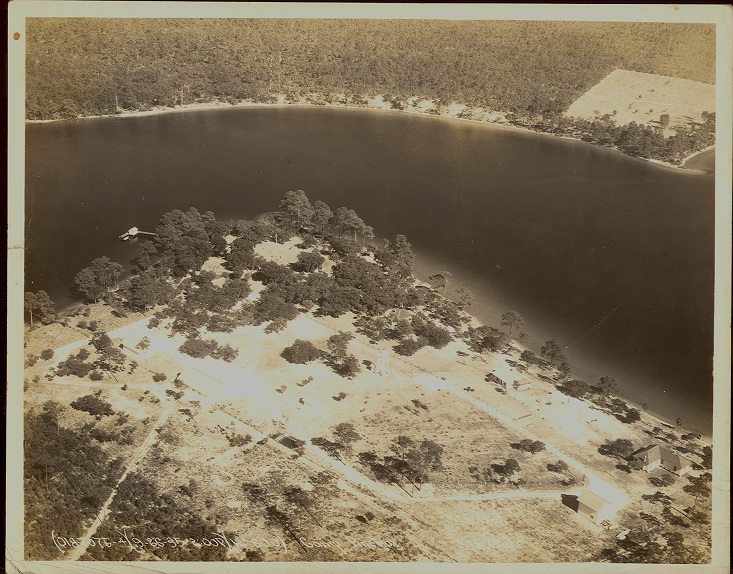
CHOCTAWHATCHEE NATIONAL FOREST MAPS
1933 Choctawhatchee National Forest Map: (Note: Map below shows location of landing field (just south of Tom's Bayou) that the CCC helped in constructing and the location of the Jackson Ranger Station in Niceville where the CCC camp was located.)
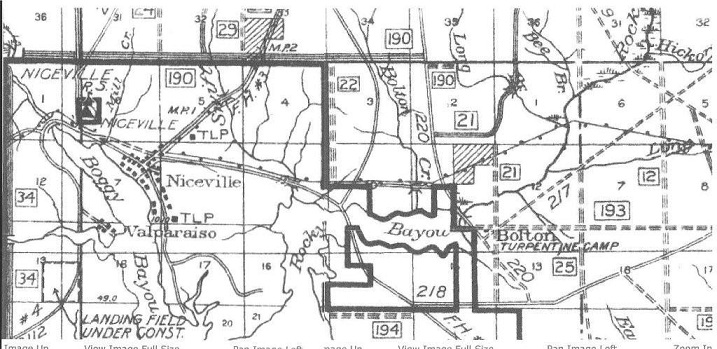
1938 Choctawhatchee Forest Map: (Source: Florida National Forests, United States Department of Agriculture, 1939. (Note: The district ranger's headquarters for the Choctawhatchee National Forest were at Niceville at the Jackson Ranger Station." Fire towers were located at Weaver Creek, Milligan, Metts, Horse Branch, Okaloosa, Camp Pinchot, Jackson, Rafter and Sandy Mountain. The recreation area is at Little Bayou, todays Poquito Bayou at Shalimar.)

Little Bayou: (Source: Panama City Pilot, June 6, 1941, Vol 32, #1941)
